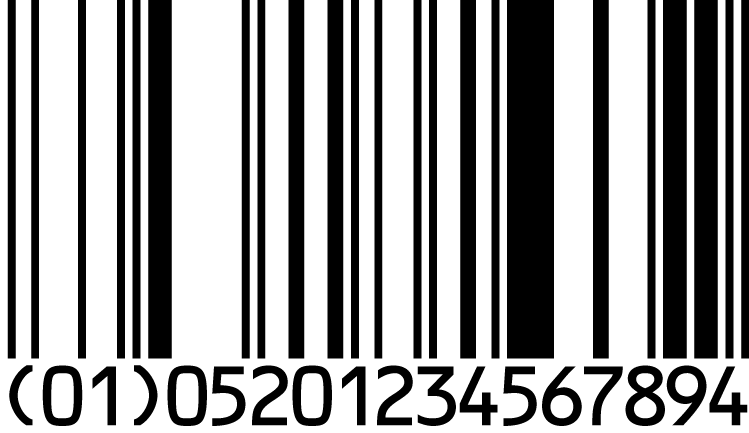GS1 Barcodes
Working with GS1, you can rest assured that your barcodes and unique numbers will be accepted by major retailers and distributors all over the world.
What is a barcode?
Linear barcodes or barcodes are symbols that can be scanned electronically using laser or image-based technology.
Depending upon the linear code they can depict various information from the GTIN of a product to the serial code SSCC of a pallet and even more data such as lot number, expiration date and more. GS1 utilises several types of barcodes to satisfy different business requirements.
Barcodes play a key role in supply chains, enabling parties like retailers, manufacturers, transport providers and hospitals to automatically identify and track products as they move through the supply chain.
8 steps to barcode implementation
EAN/UPC

The EAN/UPC family of symbols consists of the first and most widely deployed GS1 barcodes. EAN/UPC barcodes are suitable for the retail point-of-sale (POS) because they are designed for the high volume scanning environment. Applications are limited to GTIN, Restricted Circulation Numbers (RCN), coupons, and in-store codes. EAN/UPC barcodes are also applied in general distribution and logistics environments. EAN/UPC minimal sizes are increased where they must be scanned at both retail POS and in general distribution.
GS1 DataBar

The GS1 DataBar symbol depicts the GTIN of a product, but it can also hold information like an item's batch number or expiry date, in addition to other attributes used at the point-of-sale such the item weight. DataBar barcodes are often used to label fresh foods due to their small size and ability to uphold more data. Their application in retail is suggested, after agreement between business partners, when the use of laser scanners is possible.
ITF-14

ITF-14 barcodes are only applied in general distribution and logistics environments, and not applied at the retail point-of-sale (POS). The ITF-14 barcode is the most suitable to be printed directly on a corrugated box, since the requirement of quality grade is less strict. ITF-14 barcodes can only carry the GTIN and are used when no further product data needs to be shared such as expiration date, net weight or serial number.
GS1-128

GS1-128 barcodes can carry the GTIN and all GS1 keys and attributes such as serial numbers, lot numbers, expiration date, quantity, customer order number etc. They are mainly applied in logistics environments, variable measurement packaging destined for general distribution as well as the healthcare sector. They are not applied at the retail point-of-sale (POS).
Two-dimensional (2D) barcodes
2D barcodes use patterns of squares, hexagons, dots and other shapes to encode data. Because the data is encoded in a two-dimensional pattern, 2D barcodes can hold more data than 1D barcodes while still appearing physically smaller. They are used in a wide range of sectors from manufacturing to logistics and healthcare. The most widely-used are:
QR Code with GS1 Digital Link

This QR Code uses the GS1 Extended Packaging standard with Application Identifier (8200). It connects the product’s GTIN to a brand webpage, giving consumers easy access to trusted information such as ingredients, instructions, or promotions.
The newer GS1 Digital Link standard works in a similar way but uses a web-friendly format. It lets one QR Code connect to many types of information and be used for both business and consumer purposes.
GS1 Data Matrix

GS1 DataMatrix barcodes can be used to store the Global Trade Item Number (GTIN) and can carry all GS1 keys and attributes providing information such as an expiry date or a serial number. The GS1 DataMatrix is already widely adopted in the Healthcare industry for regulated healthcare trade items. They are also used for small size industrial products.
Should all barcodes have black bars and white background? No!
Typical scanners use a beam of red light to detect the contrast between the bars and spaces. A contrast that is satisfactory to the human eye may be insufficient for scanners.
The optimum colour combination for a barcode symbol is black bars with a white background. Other combinations may work if you consider the following guidelines:
- GS1 barcodes require dark colours for bars (e.g., black, dark blue, dark brown, or dark green).
- GS1 barcodes require light backgrounds for the Quiet Zones (area free of printing around the barcode) and spaces (e.g., white, red, yellow and orange).
- It is recommended to use solid colours with enough ink density of the lines to be sure there are no voids in the print.
- High-gloss substrates may change the reflectance, and checks must be made before printing.
- Transparent over-wraps may also reduce contrast and checks on the completed package should be made if over-wrapping is used.
In case of doubt, you can submit your barcodes for verification when you have a final product sample, eliminating this way any scanning problems which are costly. We can make sure you procide to any corrections, if needed, before your products enter the supply chain.
Where to place a barcode.
- Information and examples for the placement of a barcode, depending on the type of symbol, scanning environment, shape of packaging and printing method.
-
Barcodes are fun art!
They don't have to be black or rectangular, monotonous or indifferent. When graphic designers are inspired, they become even more creative and innovative, putting barcodes on products that are truly special.
How to decide the size of the barcode.
The size of the barcode affects its readability and therefore the necessary space should be provided when designing the label or package so that it is functional.
The size of the barcode to be selected depends on:
- the size of the symbol, since there are predetermined minimum and maximum dimensions.
- the scanning environment, symbols intended for retail applications may be as small as the print quality permits, whereas the barcodes for warehouse environment should be as large as it is necessary to allow scanning from a considerable distance, i.e. by an operator of a truck.
- the printing method, machines printing with pixels or dots cannot produce all permissible sizes.
We shouldn’t oversee that:
- Symbols can be scanned omnidirectionally, so a barcode that can’t be placed horizontally might work in a vertical direction.
- All barcodes must have Quiet Zones before the first and after the last line to be successfully scanned.
- The decrease in height of a symbol has a negative impact on the readability for retail omnidirectional scanners, it should be the last option when the available surface is not sufficient.
-
The GS1 General Specifications is the core standards document of the GS1 system describing how GS1 barcodes and identification keys should be used.
Why choose GS1 barcodes?
Collaborating with GS1 you can be sure that your barcodes will be accepted globally by all your associates.
GS1 barcodes belong to the most widely used coding and marking product system globally. 120 local GS1 membership organisations, 2 million business members using GS1 solutions and 10 billion daily transactions confirm that GS1 standards create the common business language.
The validity of GS1 barcodes can be certified by using Verified by GS1 database, businesses, customs, government entities, marketplaces and consumers can confirm data and detect counterfeit products.
The GS1 Registries are a set of global, neutral and trusted registries managed by GS1 offering companies and trading partners access to foundational information about products, locations and companies identified with a GS1 identifier. All of this data from the GS1 Registries is accessible through a service called Verified by GS1.
FAQs
You can search Verified by GS1 by typing the barcode of a product, logistics unit, or location and find the GS1 member company.

I need GTINs for my products
The uniqueness and validity of GTINs and GS1 barcodes is ensured only when these are issued by GS1 national associations, which consist the only reliable source for their management globally.
GS1 Association Greece is an independent, not-for-profit organisation, member of the global Organisation. It is the only legal and authorized carrier in Greece to issue and manage GS1 prefixes 520 and 521.








